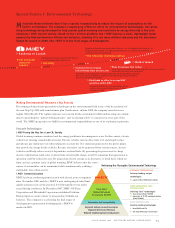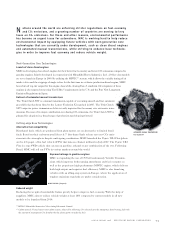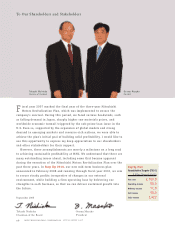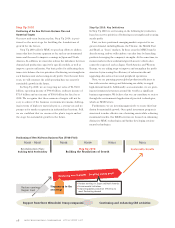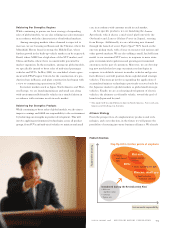Mitsubishi 2008 Annual Report Download - page 14
Download and view the complete annual report
Please find page 14 of the 2008 Mitsubishi annual report below. You can navigate through the pages in the report by either clicking on the pages listed below, or by using the keyword search tool below to find specific information within the annual report.
12 mitsubishi motors corporation annual report 2008
12 mitsubishi motors corporation annual report 2008
The new Step Up 2010 Office was established with the launch of the new mid-term business plan in April 2008. Here,
Mr. Makoto Maeda, Executive Vice President and Corporate General Manager of the Step Up 2010 Office, discusses
policies and his ambitions for the plan.
Interview With the Executive Vice President
“Whole-company” Reforms
The Step Up 2010 Office is responsible for rigorously building and
rolling out a solid earnings structure into all divisions. We aim to
embed a whole-company perspective to each department, to
achieve optimal results for the company as a whole. I am confident
that we can overcome the current challenging business environ-
ment by enabling the company to move quickly on the issues with
a shared sense of direction. This means implementing reforms in
manufacturing, costs and operations that pose solutions from a
“whole-company,” rather than a departmental, perspective.
Supporting Ambitious Employees
Manufacturing reforms are aimed at eliminating overburdening,
redundancy and inefficiency through tighter integration of all stages
from product planning to development, purchasing, production and
logistics to sales. When I was in charge of the production division, I
initiated a program called the
“Monozukuri Dojo.”
Monozukuri
means craftsmanship and a
dojo
refers to a traditional training hall.
The theme of this program was to transmit manufacturing skills to
up-and-coming ambitious employees. I also started a similar pro-
gram called
“Monozukuri juku,”
which taught about the spectrum
of processes and technologies from product planning to after-sales
service, for the purpose of adding the whole-company perspective
mentioned earlier to reform plans. My goal is to spread these activi-
ties throughout the entire company.
Enhancement of Earnings Structure
We are working to expand volume per platform, achieve further
standardization of parts with fewer categories, and boost global
production efficiency. We want to bring together the company’s
collective expertise to optimize costs.
Additionally, to generate stable profits, in mature markets
where future growth cannot be expected we are looking beyond
new-vehicle sales to expanding profits from peripheral businesses
such as after-sales services.
We will make progress toward our goals by breaking down barriers
between divisions and bolstering our capabilities on the factory
floor with improved manufacturing techniques. We will overcome
the issues before us one by one. Our goal for fiscal year 2010 is to
make MMC a stronger company that can achieve sustainable
growth in the years to come.
September 2008
Makoto Maeda
Executive Vice President,
Corporate General Manager of
Step Up 2010 Office



